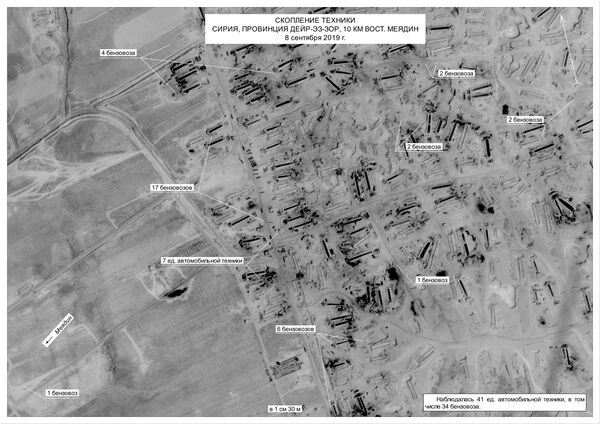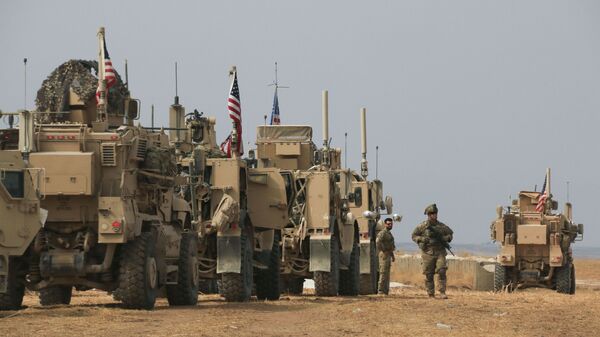US forces crossed into Syria on route to oil fields in Deir ez-Zor province, a US defence official confirmed to NBC News on Saturday. The deployment was said to be aimed at preventing Syrian oil fields from coming under the control of Daesh (ISIS)* or other ‘destabilisizing actors,’ according to the unnamed official.
“We will not discuss details or timelines of those forces for security reasons,” the official said.
Earlier, CNN reported that the crossing had taken place, citing a Kurdish Regional Government official and Syrian Democratic Forces fighters. Two sources said to be inside Syria further confirmed to NBC that they witnessed a US military convoy driving toward Deir ez-Zor.
The convoy, said to consist of as many as 18 vehicles, and supported by a pair of US Army Apache attack helicopters, zipped past the city of Qamishli, where both Syrian and Russian military police had established a presence in recent days, on route to their destination.
Multiple videos and images, including by the Associated Press and Iran’s PressTV, showed the troops on the move through northeastern Syria.
US military convoy heads towards #Kurdish-held #oil fields east of #Syria pic.twitter.com/a2e90by97d
— Press TV (@PressTV) October 26, 2019
US military vehicle, part of a convoy arriving from northern Iraq, drives past an oil pump jack in the countryside of Syria's northeastern city of Qamishli on October 26, 2019. (Photo by Delil SOULEIMAN / AFP) pic.twitter.com/uvcuemGvI5
— Delil souleiman (@Delilsouleman) October 26, 2019
And so they are back. US convoy drives back to Syria. Here it is passing in Qamishli, just a day before the Russian MP were driving by the exact same street. This is a twist in a serious of events that are getting crazier and crazier.@Delilsouleman nails the picture of the day. pic.twitter.com/6srXXzxFaN
— Benedetta Argentieri (@benargentieri) October 26, 2019
#BREAKING: Escorted by a pair of #USArmy AH-64E attack helicopters, the convoy of 13 MRAPs & armoured carriers of #US Special Forces can be seen passing through #Qamishli/#Qamishlo & moving toward #DeirEzzor to protect #Syrian oilfields from being captured by #Syria Arab Army. pic.twitter.com/977gD2JM50
— Babak Taghvaee (@BabakTaghvaee) October 26, 2019
On Friday, US Secretary of Defence announced that the US would continue to maintain a “reduced presence” in Syria, including control of oil fields the Pentagon chief were at risk of falling to Daesh terrorists. The Pentagon’s announcement was a reversal from a pledge made last week to withdraw the entirety of its 1,000 troop strong presence in northern Syria after Turkey launched a military operation in the area to drive Kurdish militia and Daesh militants away from the border area.
On Saturday, Russia’s Defence Ministry released satellite intelligence showing that US servicemen and private security contractors had engaged in the illegal export of Syrian oil from Kurdish-held areas. In a presentation, Maj. Gen. Igor Konashenkov described US actions as “international state banditism,” and said that Syria’s oil belongs to the Arab Republic, and not to Daesh or to any “American protectors from Daesh.” According to the officer, the Pentagon and the CIA were earning over $30 million per month on their illegal enterprise, and would be “ready to ‘guard’ Syrian oil wells from ‘hidden Daesh cells’ indefinitely.”

President Trump has repeatedly said in recent weeks that although the US was reducing its military presence in Syria in the wake of the Turkish invasion, it was keeping the oil in the country “secure.”
The US withdrew forces from northern Syria earlier this month as Turkey launched an invasion of the border area, with Ankara’s operation ostensibly aimed at clearing the area of Kurdish militia, whom Turkey considers ‘terrorists’, as well as any Daesh remnants. The United States and Turkey reached a ceasefire agreement in the region last week amid an international outcry over the Turkish invasion, with Russian President Vladimir Putin and Turkish President Recep Tayyip Erdogan later meeting in Sochi to work out a deal in which Syrian Kurdish forces would withdraw 30 km from the Turkish border in exchange for a halt to the Turkish operation. Later, the Syrian Army began deploying to areas formerly controlled by Kurdish militias in northern Syria, with major settlements declaring allegiance to Damascus amid the perceived inability of Kurdish authorities to protect the local population.
*A terrorist group outlawed in Russia and many other countries.




